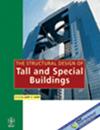开槽螺栓抗震连接设计理论与数值分析
IF 1.3
3区 工程技术
Q3 CONSTRUCTION & BUILDING TECHNOLOGY
引用次数: 0
摘要
预制钢结构采用螺栓连接,具有质量控制和施工方便等优点。提出了一种新型的开槽螺栓连接抗震连接(ERJ - SBC),以实现钢结构的损伤控制和延性改善。假设SBC的弯矩主要由翼缘段传递,剪力主要由腹板段承担。ERJ - SBC的能量耗散能力是由SBC在较大位移下的初始摩擦滑动和非弹性轴向变形提供的。提出设计理论,以确保非弹性变形集中在SBC,而其他结构构件保持弹性。通过44个有限元算例的数值分析,研究了槽孔长度、螺栓预紧力、摩擦系数、滑板厚度和宽度等因素的影响。推导并验证了影响ERJ - SBC塑性旋转性能的槽孔临界长度的计算方法。结果表明:螺栓与开槽孔碰撞时,螺栓连接机制由摩擦阻力转变为承载阻力,开槽孔的摩擦滑移行为有利于螺栓的滞回性能、变形能力和旋转性能。本文提出的ERJ - SBC力学性能计算方法与仿真结果吻合较好。合理设计的ERJ - SBC具有良好的承载力和转动性能,并能实现损伤控制。本文章由计算机程序翻译,如有差异,请以英文原文为准。
Design theory and numerical analysis of earthquake‐resilient joint with slotted bolted connection
Bolted connections are preferred in prefabricated steel structures with the advantages of quality control and convenient construction. An innovative type of earthquake‐resilient joint with slotted bolted connection (ERJ‐SBC) is proposed to achieve damage control and improve the ductile behavior of steel structures. The bending moment is assumed to be mainly transferred by the flange segments of SBC while the shear force is carried by the web segments. The energy dissipation capacity of ERJ‐SBC is provided by the initial frictional sliding and inelastic axial deformation of SBC under larger displacement. Design theory is proposed to ensure that inelastic deformation is concentrated in SBC while other structural members remain elastic. The influences of the length of slotted holes, bolt pretension, friction coefficient, and the thickness and width of the sliding plate are investigated through the numerical analysis of 44 FE examples. The calculation of the critical length of slotted holes for the ductile rotation behavior of ERJ‐SBC is derived and verified. Results demonstrate that the mechanism of bolted connection shifts from friction resistance to bearing resistance when bolts collide with slotted holes, and the friction slippage behavior with slotted holes benefits the hysteresis behavior, deformation capacity, and rotation behavior. The proposed calculation methods for the mechanical behavior of ERJ‐SBC could achieve good accuracy with simulation results. A reasonably well‐designed ERJ‐SBC could have good bearing capacity and rotation behavior, and it could also achieve damage control.
求助全文
通过发布文献求助,成功后即可免费获取论文全文。
去求助
来源期刊
CiteScore
5.30
自引率
4.20%
发文量
83
审稿时长
6-12 weeks
期刊介绍:
The Structural Design of Tall and Special Buildings provides structural engineers and contractors with a detailed written presentation of innovative structural engineering and construction practices for tall and special buildings. It also presents applied research on new materials or analysis methods that can directly benefit structural engineers involved in the design of tall and special buildings. The editor''s policy is to maintain a reasonable balance between papers from design engineers and from research workers so that the Journal will be useful to both groups. The problems in this field and their solutions are international in character and require a knowledge of several traditional disciplines and the Journal will reflect this.
The main subject of the Journal is the structural design and construction of tall and special buildings. The basic definition of a tall building, in the context of the Journal audience, is a structure that is equal to or greater than 50 meters (165 feet) in height, or 14 stories or greater. A special building is one with unique architectural or structural characteristics.
However, manuscripts dealing with chimneys, water towers, silos, cooling towers, and pools will generally not be considered for review. The journal will present papers on new innovative structural systems, materials and methods of analysis.

 求助内容:
求助内容: 应助结果提醒方式:
应助结果提醒方式:


